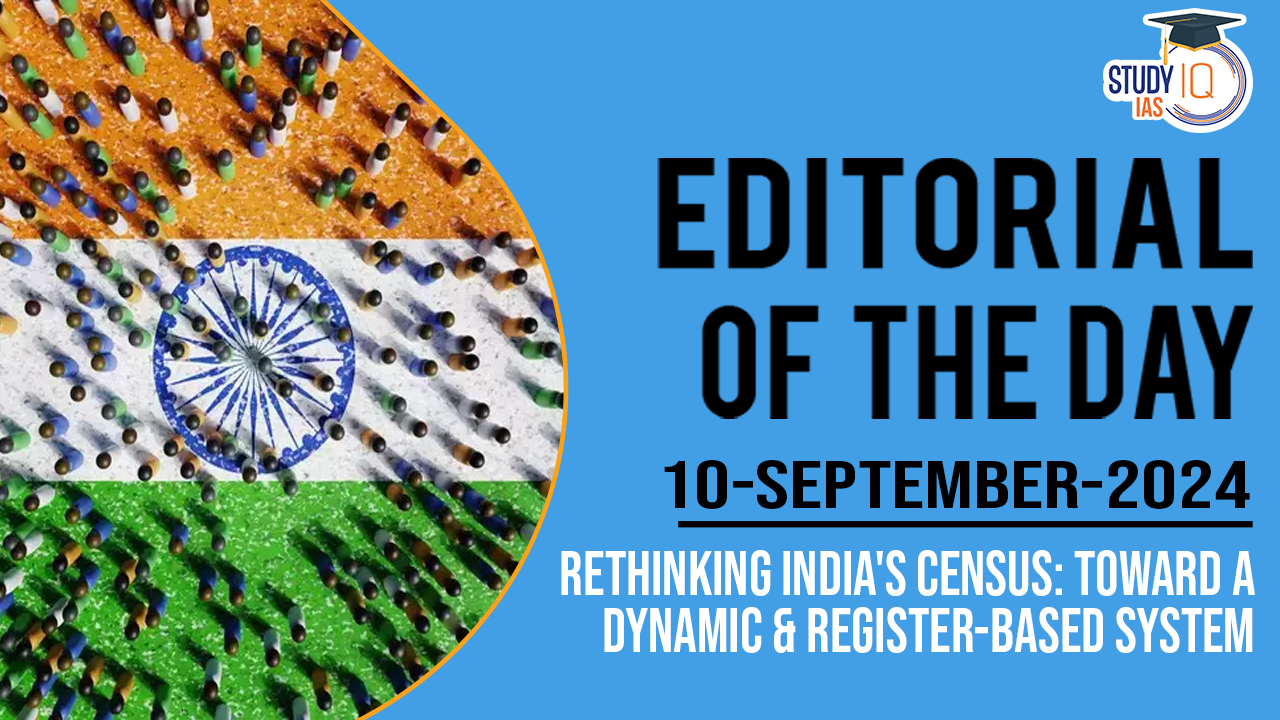Table of Contents
Context: India is expected to commence its long-overdue Census in September 2024, with the survey projected to take 18 months to complete. Consequently, the final report is anticipated to be available by late 2026 or in 2027.
What is the Population Census?
- It is a comprehensive process of collecting, compiling, analysing, and disseminating demographic, economic, and social data of all persons in a country at a specific time.
- It serves as a tool to review a country’s progress over the past decade, monitor ongoing government schemes, and plan for the future.
Census in India
- It is conducted by the Office of the Registrar General and Census Commissioner, Ministry of Home Affairs.
- The first synchronous census in India was conducted in 1881 by W.C. Plowden.
- Since then, censuses have been conducted every 10 years without interruption.
- The Census of India Act of 1948 provides the legal framework but doesn’t specify timing or periodicity.
|
Fact |
|
| Facts |
BRICS and Neighboring Countries
|
Impact Due to Lack of Updated Census
- Trust Factor: Outdated census data from 2011 impacts the reliability of assistance programs. Both beneficiaries and non-beneficiaries are affected, and researchers and policymakers are forced to rely on old or less precise data sources.
- Data Dependency: Other national surveys, such as the National Family Health Survey (NFHS-5), rely on census data. The 2011 census data was used for the NFHS-5, leading to potential inaccuracies in recent analyses.
- Funds Allocation: The Finance Commission uses census data to allocate funds to states. Delayed or outdated data can lead to disproportionate funding distribution.
- Migration Data: Census data is critical for understanding migration patterns and their economic impacts. The delay hinders policymakers from accessing updated domestic and international migration information.
- Delimitation/Reservation of Constituencies: Panchayats experiencing significant population changes may have inaccurate seat reservations.
- Rural-Urban Population Distribution: Urban population growth has varied significantly across cities.
- Example: the Bruhat Bengaluru Mahanagara Palike saw a 49.3% increase between 2001-2011, while other cities like Mumbai, Delhi, and Chennai experienced much lower growth rates.
What are Register-Based and Dynamic Censuses?
- Register-based Census:
- This method relies on existing administrative records and databases maintained by various government agencies.
- These records include data from population registers, tax records, employment records, school enrollments, and health records.
- The key advantage is that it reduces the need for extensive fieldwork and surveys, making the process more efficient and cost-effective. Countries like Denmark, Finland, and the Netherlands have successfully implemented register-based censuses.
- Dynamic Census:
- A dynamic census continuously updates population data in real-time.
- This approach integrates various data sources and updates the census database as new information becomes available, such as births, deaths, and migrations.
- This method ensures that the census data is always current, providing more accurate and timely information for policy-making and planning.
Why India Needs to Shift From Decennial Census to Register-based Census and Dynamic Census?
- The current decennial Census model in India is resource-intensive, costly, and time-consuming.
- India’s digital advancements, including the widespread use of Aadhaar, voter ID, and mobile numbers, make it feasible to move towards a register-based or dynamic Census.
- A register-based model would enable more frequent and accurate updates, critical for sectors like healthcare, education, and employment where rapid demographic shifts occur.


 Places in News for UPSC 2025 for Prelims...
Places in News for UPSC 2025 for Prelims...
 New Phase of Operation Chakra to Combat ...
New Phase of Operation Chakra to Combat ...
 Soyuz Aircraft: History, Design and Sign...
Soyuz Aircraft: History, Design and Sign...





















